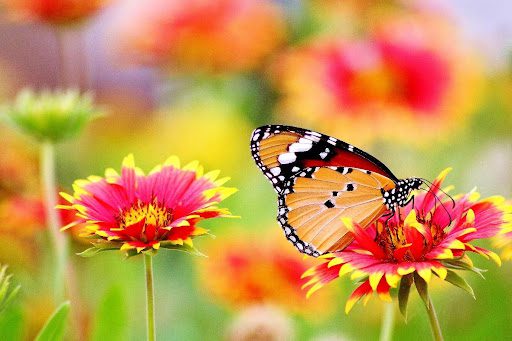Butterflies are a joy to see flitting around in the garden, and they can be a great indicator of the health of your plants. Not only that, but they provide an important service to Maine gardens by pollinating flowers. If you want to attract these beautiful creatures to your garden, there are certain plants you can include in your Maine landscape.
Maine is home to more than 120 species of butterflies, so you’re sure to find some that are interested in the plants in your garden. If you’re unsure where to start, consider adding some or all of the following pollinator plants to your garden.
Adding Native Plants & Flowers
One of the best things you can do to attract butterflies (and other pollinators) is to include native plants in your garden. Native plants are those that are naturally found in an area and have evolved to co-exist with the local wildlife. This means they’re more likely to provide butterflies with food and shelter. They don’t require as much care as non-native plants, and they’re better able to withstand local pests and diseases.
Despite their many benefits, native plants can sometimes be difficult to find. Your best bet is to check with your local nursery or garden center, as they may carry a selection of native plants. You can also order them online from several specialty nurseries. Whatever route you choose, make sure to do your research so that you select plants that are well-suited to your climate and growing conditions.
Most of the plants on this list are native to Maine, so you’ll be providing a valuable resource for the butterflies in your area. As a bonus, incorporating native plants can help to restore local ecosystems and support the overall health of your community.
Spring (April-May)
Marsh Marigold
The early bird may catch the worm, but in the world of butterflies, it’s the early bloomer that gets the most attention. Marsh marigold (Caltha palustris) is one of the first flowers to bloom in the spring, making it a prime target for early-season pollinators. The large, yellow blossoms are a welcome sight after a long winter, providing a much-needed source of nectar for butterflies, bees, and other insects.
Marsh Marigold is also relatively easy to care for, requiring only a sunny location and moist soil. It’s a good choice for rain gardens or other wet areas of the garden, and can even tolerate some standing water. Given its many benefits, it’s no wonder that Marsh Marigold is one of the most popular plants for butterfly gardens.
Black Chokeberry
Black chokeberry (Aronia melanocarpa) is another great pollinator plant for the early season. This deciduous shrub produces small, white flowers in the spring that are a favorite of bees and butterflies. The flowers give way to clusters of blackberries in the summer, which provide food for birds and other animals.
The black chokeberry is native to North America and can be found in woodlands, wetlands, and along streams and rivers. This versatile plant is easy to care for and thrives in various soil types. It’s also tolerant of drought and deer browse, making it a good choice for areas where other plants might struggle. With its attractive flowers and fruit, the black chokeberry is a great addition to any landscape.
Crocus
Crocus is a member of the Iris family, prized for its showy, early-blooming flowers. These bulbs produce blooms in various colors, including yellow, purple, white, and pink. The flowers are a favorite of butterflies and other pollinators, providing an important source of nectar in the early spring.
Crocus is relatively easy to care for, though it requires specific growing conditions. The bulbs should be planted in the fall in well-drained soil that receives full sun to partial shade. With its bright blooms, the crocus is a welcome addition to any butterfly garden.
Early Summer (June)
Flowering Onion
The flowering onion (Allium cernuum) is a member of the Allium family that produces showy, globe-shaped flowers in the summer. This perennial plant is native to North America and can be found in woods, meadows, and hillsides. The flowering onion blooms from June to August and grows to a height of 24 inches.
The flowers of the flowering onion are a favorite of bees and butterflies, and the plant is also attractive to hummingbirds. The bulbs should be planted in the fall in well-drained soil. Once established, they will naturalize readily and come back year after year with very little care.
Japanese Bleeding-heart
This perennial flower is native to Japan and is often found in mountain meadows. The plant gets its name from its heart-shaped flowers, which range in color from pink to red. The plant leaves are dark green and glossy, and the stems are slender and graceful. The Japanese Bleedingheart blooms from late spring to early summer, attracting various butterflies with its colorful flowers.
In addition to being attractive to butterflies, the Japanese Bleedingheart is also deer resistant and deer proof. The plant does best in full sun or partial shade and moist, well-drained soil in Maine. The plant will spread slowly over time, but it can be easily controlled by division or by removing excess plants in the spring. With a little care, the Japanese Bleedingheart will provide color and beauty to your butterfly garden for many years.
Mid Summer (July)
White Turtlehead
The White Turtlehead is a beautiful addition to any butterfly garden. Its nectar-rich flowers attract a variety of butterflies, and its dense foliage provides them ample places to rest and lay their eggs. The White Turtlehead is also known for its long bloom period, which means that butterflies can enjoy its nectar throughout the summer months.
The White Turtlehead is a native plant, so it is well-suited to the climate and soil of North America. It is also a hardy plant that can tolerate a wide range of growing conditions, from full sun to partial shade. Best of all, the White Turtlehead is relatively low-maintenance, requiring little more than occasional watering and trimming.
Late Summer (August – September)
Aster
The Aster is a beautiful flower that is well-suited for butterfly gardens. The flower’s disk shape is perfect for providing nectar for butterflies, and the distinctive petals make it a favorite among gardeners. Asters come in a range of colors, including white, pink, purple, and blue, making them a versatile addition to any garden. In addition to attracting butterflies, asters are also known for their ability to attract bees and other pollinators. This makes them an ideal plant for gardens that are striving to promote biodiversity.
Asters are easy to grow and require little maintenance, making them a great choice for gardeners of all skill levels. With so many positive attributes, it is easy to see why the Aster is such a popular choice for butterfly gardens.
Bottle Gentian
The Bottle Gentian is a beautiful flower that is perfect for attracting butterflies to your garden. Its deep blue petals are a striking contrast to its white center, and the flower blooms from summer until fall. The Bottle Gentian is also a great choice for gardens that require some color. The flowers add a splash of brightness to any garden, and they are also known for being very fragrant. The Bottle Gentian is also very easy to care for. It is a low-maintenance plant that does not require much water or fertilizer.
Design Tips For Your Butterfly Garden
Now that you know what plants to include in your butterfly garden, it’s time to start thinking about design. Here are a few tips to help you create a beautiful and functional space:
Use Various Plant Heights
It’s important to have a variety of plant heights in your butterfly garden for both visual appeal and functional purposes. Place taller plants in the back of the garden so they won’t block the view of shorter plants in the front. This way, everyone can enjoy all the beauty your butterfly garden has to offer.
Don’t Forget To Include A Water Feature
Incorporate a water feature into your garden. Butterflies need water for both drinking and bathing. A birdbath or small fountain would be the perfect addition to your garden. Just be sure to place it in a safe area, away from where children or pets play.
Choose The Right Location
When selecting a location for your butterfly garden, it’s important to choose an area that gets plenty of sunlight. Butterflies are cold-blooded creatures, so they need the sun’s warmth to be active. If you live in an area with hot summers, you may want to consider placing your garden in a spot that gets some afternoon shade. This will help keep your plants and butterflies from getting too overheated.
Stop Relying On Insecticides
If you want your butterfly garden to be truly successful, you need to stop using insecticides. These chemicals can be harmful to butterflies and other pollinators. Instead, focus on using plants that naturally repel pests. This will create a safer environment for your butterflies and help promote the health of the entire ecosystem.
Create A Windbreak
Butterflies are very sensitive to wind, so it’s important to create a windbreak in your butterfly garden. This can be as simple as placing a few large rocks or logs around the garden’s perimeter. This will help keep your butterflies safe and sound.
Final Thoughts
With a little planning and effort, you can create a butterfly garden that is beautiful, sustainable, and beneficial for the local ecosystem. By including a variety of native plants, you’ll provide butterflies with the food and shelter they need to thrive. In return, you’ll be rewarded with a colorful, fragrant garden that will bring you joy for years to come.
Are you ready to attract more butterflies and other pollinators to your Maine garden? Stone Solutions Maine can help you create the perfect butterfly garden. Contact us today for a free consultation

